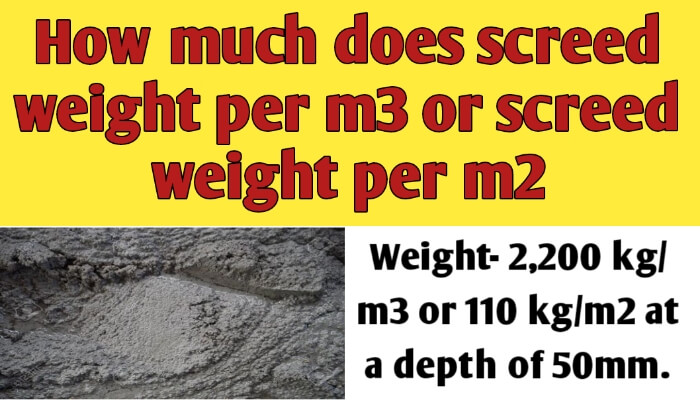The weight of screed per cubic meter (m³) can vary depending on mix ratio of sand and cement and the type of screed being used. However, on average, traditional sand and cement screed typically weigh approximately 2,200 kilograms per cubic meter (kg/m³), an engineered screeds weighing closer to 2,400 kg/m³, and lightweight screeds weight from 1,600 to 1,800 kg per m3.

The weight of screeds can change slightly based on the composition of sand & cement and some additives used in the screed mixture. Generally the density of screed is range from 2,200 to 2,400 kilograms per cubic meter (kg/m³) or about 22 kN/m3.
The weight of screed per square meter can vary based on several factors including the thickness of the screed, the type of screed material used (e.g., cementitious, anhydrite, polymer-modified), and the density of the material.
As a rough estimate, traditional sand and cement screed typically weigh around 2,200 kilograms per cubic meter (kg/m³) or approximately 55-110 kilograms per square meter (kg/m2) at a depth of 25-50mm.
A screed is a layer of material laid in situ, directly onto a base, for one or more of the following purposes: to obtain a defined level, to carry the final flooring and to provide a wearing surface.
Screeds may be three types: 1) Fully bonded: this make well bonded to the base, 2) Unbonded: this not bonded to the base- typically applied where a DPM is placed under the screed, and 3) Floating screeds: this is used to enable installation of thermal or impact sound insulation.
The average thickness of a sand and cement bonded screed is range from 25 to 40mm, while the minimum thickness for an unbonded screed should have a 50mm. In addition, the average thickness for floating screed is about 65mm for lightly loaded floors and 75mm for more heavily loaded floors.
However, for estimation purposes, the standard thickness for screeds is about 50 mm and the minimum thinnest screed layer is not less than 15 mm.
To determine how much screed you need, you’ll need to calculate the square meters area you intend to cover and the depth of the screed you want. Multiply the area (length x width) in square meters by the thickness in meters. This will give you the volume of screed needed in cubic meters.
Here’s are general guideline for how much does screed weight per m3:-
- The typical weight of traditional sand and cement screed is approximately 2,200 kg/m3 or approximately 110 kg/m2 at a depth of 50mm.
- The typical weight of an engineered screed is approximately 2,400 kg/m3 or approximately 120 kg/m2 at a depth of 50mm.
- The typical weight of lightweight screed is range between 700 to 1,800 kg/m3 or about 35 to 90 kg/m2 at a depth of 50mm.
- The typical weight of an unbonded screed is range between 1,850 to 2,000 kg/m3 or approximately 93 to 100 kg/m2 at a depth of 50mm.
- The typical weight of floating screed is approximately 1,800 kg/m3 or approximately 90 kg/m2 at a depth of 50mm.